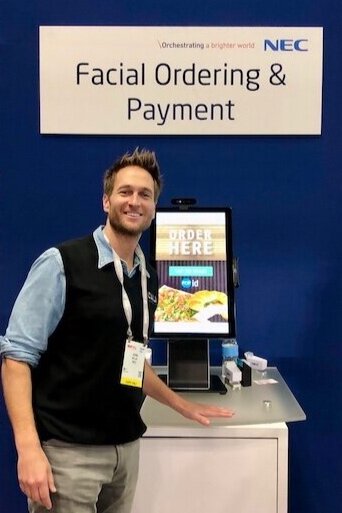This week I attended NRF, Retail's Big Show, for the first time. The sheer size of the production is nothing short of impressive. Navigating the 840,000 square feet of the Javits Center in New York, it's hard to believe retail is struggling through a 'retail apocalypse.' The show is a beacon of retail strength, with a reported 40,000 attendees representing retailers, vendors, consultants, media, and thinkfluencers from across the retail spectrum, walking the conference in search of their place in the future of a $30 trillion industry. Speakers ranged from Kevin Johnson of Starbucks and Corie Barry of BestBuy to Satya Nadella of Microsoft and Gwyneth Paltrow of Goop. Four booth-lined floors featured everything from self-checkout POS and eCommerce marketing tools to warehouse robots and employee HR tools. The international presence at NRF was also surprisingly robust. Significant contingents (I'm talking planeloads) from Japan, Israel, France, and Brazil walked Javits like a historical site, huddled in groups of 20 complete with a guide, group sign, and in-ear live translation as they navigated vendors (myself included) hawking their wares.
One part of one floor!
Three main themes stood out to me as I walked the show talking to retailers, tech providers, and consultants.
1. Payments experiences are still hard
The number of payments providers at the show gave me Money2020 flashbacks. Massive booths stretched toward the ceiling, sporting various payment terminals, POS platforms, and checkout software. Everyone promised a truly omnichannel payment platform, complete with integrated settlement, international coverage, and the right hardware to satisfy all your payment needs. Looking for self-checkout? No problem. Run apps on your POS device? I've got just the thing. Mobile readers to equip all your associates? I've got that too. Pay by card, pay by thumbprint, pay by face all on display. There are so many ways people can pay now I'm shocked no one has built pay-by-ass (yes, it's a link, yes, it's suitable for work). Why so many payment providers? Despite being in a digital age with global payment volumes in the trillions of dollars a year, building a comprehensive payments platform that simultaneously satisfies all the business requirements and delivers the desired customer experience is still very hard. There is just no one size fits all solution.
Pay by face
2. Customer experience means a LOT of different things
"The customer is king" is truer today than ever before. Retailers know that they need to deliver better customer experiences first to earn the patronage, then the loyalty of their customer base. How they are choosing to go about it is an entirely separate thing. Nordstrom is offering alcohol while you shop, with Co-President Erik Nordstrom saying to the crowd at NRF, "I don't know why it took us so long to put drinking and shoes together, but it's a great combination." A great combination presumably because the drunker you get, the longer you'll stay and more you'll spend. On the other hand, BJ's Wholesale CEO, Christopher Baldwin, talked about the need for speed - getting the consumers what they want as fast as possible and helping them move on. Meanwhile, Target is off creating a seamless experience across both their online and offline stores, after "the realization that our 1,800 stores are also distribution points for digital sales", said CEO Brian Cornell. He views their stores as "their single biggest advantage", whereas Walmart views a technology-driven experience as the differentiator. Like with payments, there is no one size fits all, and I expect to see immense learning come from failed retail experiments.
3. The employee experience is more important than ever
While there might be differences of opinion on the best way to create payments and customer experiences, the one consistent theme across retailers was the importance of creating a positive employee experience. As one VP of Store Operations at a top 500 retailer commented to me, "Anyone who isn't treating their employees right is in for it. Happy employees mean happy customers." With unemployment at a 50-year low, attracting talent is harder than ever. Given the high cost of worker replacement, it makes sense that creating a positive work environment that empowers employees is an area of focus for retailers. Workers have (understandably) come to expect mobile-first tools, flexibility and predictability in their schedules, engagement with their employer, and opportunities for development. Walmart US CEO John Furner told the NRF crowd, "There's no better investment you can make than in the people you have on your team, who are serving the people that are paying you to be there." Later, Starbucks CEO Kevin Johnson reiterated the message saying, "I think one of the common themes going forward is finding ways to create human connection. Human interaction." As the millennial generation of hourly workers enters the workforce, increasingly willing to try new things and serve as catalysts for change within an organization, retailers that innovate around employee benefits will gain the advantage of being first movers. Given retail is the largest single-sector private employer in the US, supporting 1 in 4 jobs, hopefully these changes trickle down to benefit the rest of the economy as well.
“"There's no better investment you can make than in the people you have on your team, who are serving the people that are paying you to be there." - John Turner, Walmart US CEO
Picture credit: NRF
Crafting end-user experiences is hard. Doing so when the end-user is continuously changing is near impossible. The retail industry is in the middle of a drastic change, but if NRF is a leading indicator of what’s to come, the future seems bright…for the consumer anyway!
*********
I publish a weekly newsletter called Tippets by Taps. It’s a curated set of notes on the latest in commerce, retail, the future of work, as well as a few fun tidbits from around the web. If you’d like to join hundreds of similarly curious, intelligent people who've already subscribed, click below!



